
Charley Amos, pictured above in his favorite birding spot, Big Bend National Park, shares his secrets for attracting birds to his suburban yard. Photo courtesy of FB. Bird photos by Charley Amos.
Jan. 22, 2020
How many bird species have visited your yard? 10? 15? Maybe even 20? For bird expert and Texas Master Naturalist Charley Amos, the tally for his “yard list” is an eye-popping 97.
 House finch is one of dozens of species found in Charley Amos' yard.
House finch is one of dozens of species found in Charley Amos' yard.
Amos, who lives in North Arlington near River Legacy Park and has twice served as president of the Fort Worth Audubon Society, says luring lots of feathered friends to your yard is a simple matter of garden hospitality.
“Water is probably the most important thing to make available, and you should keep those birdbaths and ponds clean,” Amos said. “The way I like to look at it, if I wouldn’t drink it, then I shouldn’t expect my birds to drink it.”
Most avian yard-party drop-ins like to have seeds and berries on the menu, especially those produced by indigenous plants.
“Birds will be looking for native seeds and native berries, and if they find them in your yard they’ll come to your yard,” Amos said.
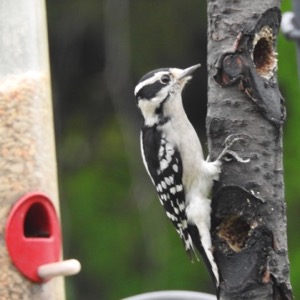 Downy woodpecker.
Downy woodpecker.
Examples include pokeweed, which grows a dark-red berry that many birds crave, Virginia creeper, inland sea oats, gramma grass and American beautyberry. Thistle seeds are appealing to sparrows and the showy painted bunting. Mulberry, pecan and other fruit- or nut-producing trees typically supply prodigious amounts of food for many bird species. See this comprehensive list of bird-attracting plants by Zip Code.
For your bird feeder, black-oil sunflower seed is the gold standard.
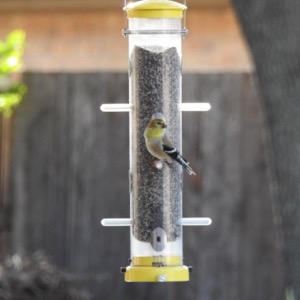 An American goldfinch stops at a feeder.
An American goldfinch stops at a feeder.
“Whatever kind you use, make sure it’s fresh and good and hasn’t been sitting around in someone’s warehouse for six months,” Amos said. “Black-oil sunflower seed is the easiest for them to crack the shell and get to. It also has the most proteins and fats in it that they need.”
For bird lovers who’d rather not deal with the mess of black shells all over the ground – and Amos counts himself among them - already-shelled “no-mess” seeds are available at a slightly higher price.
Amos strongly advises against the use of all yard chemicals. Pesticides can kill the bugs, worms and caterpillars that many birds eat, and poisoned survivors that are eaten can transmit the chemical to the bird. Likewise, herbicides can kill or taint plants that serve as birds’ food sources.
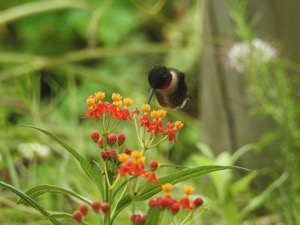 A ruby-throated hummingbird sips from a milkweed.
A ruby-throated hummingbird sips from a milkweed.
“I haven’t used chemical pesticides, herbicides or fertilizers on my yard for 30 years, and my grass is as green as anybody’s on the street, the flowers are doing great, there’s always bees and I have two or three kinds of lizards that keep the pests down. You don’t have to do all that chemical stuff,” he said.
Finally, you can provide shelter for winged visitors in the form of birdhouses, brush piles or tree canopies.
“Something for them to find safety and cover from danger, like storms, predators, things of that nature,” he said.
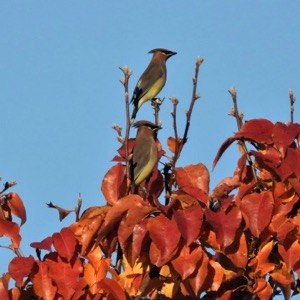 Cedar waxwings.
Cedar waxwings.
Habitat loss and chemical-intensive agriculture have resulted in dramatically reduced sightings of some birds in recent years, Amos said. Black-capped vireos and golden-cheeked warblers, for example, were once common but are now endangered.
“A lot of our birds suffer because of monocrop agriculture. When you have several hundred-thousand square miles of corn or soybeans, and you spray all kinds of pesticides and herbicides all over that, it’s not going to do the birds any good, or butterflies or bees or anything else, for that matter. That’s up in the plains, but we bear the brunt of it here when they migrate,” he said.
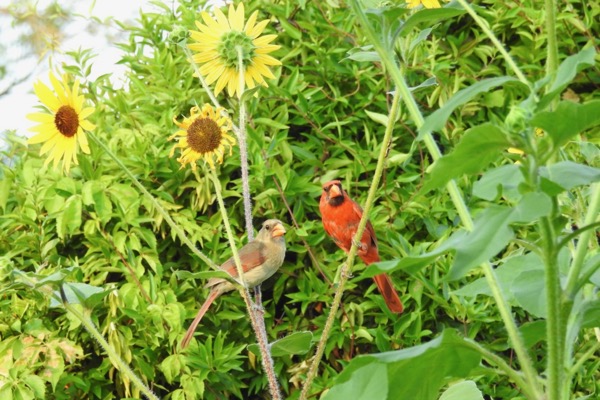 A pair of cardinals perch in Charley Amos' Arlington yard.
A pair of cardinals perch in Charley Amos' Arlington yard.
Amos leads nature walks birding expeditions around DFW and Texas, and has traveled to Canada, Europe, Ecuador and Costa Rica to build up his life list. (His favorite bird-watching venue is Big Bend National Park, Texas.) Out of the 1,116 bird species in North America, he has identified and logged 705 of them, and his overall worldwide count is almost 1,200. That includes the 97 in his yard list. If you’re discouraged about falling short of Amos’ big backyard score, don’t give up. The American Birding Association says you get full credit for a sighting if the bird is overflying your property, or even if it’s out of view but you can hear and identify its tweeting, hooting or squawking from your yard.
Stay up to date on everything green in North Texas, including the latest news and events! Sign up for the weekly Green Source DFW Newsletter! Follow us on Facebook and Twitter. Also check out our new podcast The Texas Green Report, available on your favorite podcast app.









